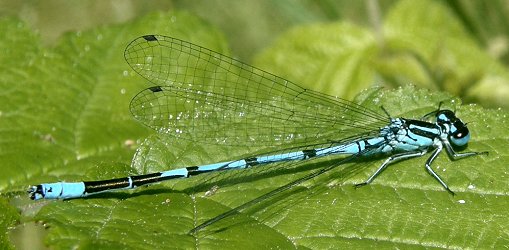It’s the time of year in the UK when dragonflies and damselflies
are emerging. The margins of ponds, streams and lakes start to harbour blue,
red or other coloured damselflies, while their larger and variously coloured relatives,
the dragonflies, fly over the water searching for prey insects. Yesterday, I
was visiting ponds in Norfolk and came across many azure damselflies (Coenagrion puella), the bodies of males being
a striking combination of blue and black, with the females rather duller (despite
their common name, there are male and female damselflies). They were flying around
the vegetation and occasionally perching and it was clear that some were newly
emerged from the ponds where they had been living as larvae since last summer,
as their colours had not developed fully. One adult, just minutes after
emerging, became the victim of a spider, which grabbed the damselfly resting on
a plant stem and took it to the base of the plant to be devoured later. A piece
of “raw” Nature and one that reminded me that my love of watching damselflies and
dragonflies is based on my very partial knowledge of how Nature really is, as
well my aesthetic appreciation of the insects.
Dragonflies and damselflies (I’ll call them Odonata, as that
is the name for the Order) are beautiful to look at, and are very well
engineered, but that is not for my benefit. They have existed in much the same form
as we see them today for well over 100 million years. We cannot comprehend such
a period of time, but we are fairly sure that there were no humans for 99.8% of
the time that the contemporary Odonata have been in existence. It is quite extraordinary
to know that all the stages of their evolution, from a single cell to the complex
insects we know today, occurred way before 100 million years ago: the development
through larval stages, with moults to increase size; the ability to fly and
change direction rapidly; the development of excellent vision; the different catching
devices of larvae and adults. I could go on and on in making a list of features
and they were all in place so very long ago, with the successful pattern being repeated
through more than 100 million generations. Of course, there are some who cannot accept this view and among
the more famous of these was Philip Henry Gosse, the excellent Victorian Natural Historian and author of Omphalos, 1 in which he
explained that Creation occurred as described literally in the Holy Bible, over
a period of days. To him, fossils (including those of the Odonata, some of which
are of much larger forms than are found today) were part of that Creation and
it is a view which is still held by some.
The folklore surrounding damselflies and dragonflies is even more odd than the explanations
provided by Creationists like Gosse. As their common name might suggest, it is the dragonflies, rather
than their smaller and more delicate relatives, the damselflies, which feature
in most folklore. A review is given in Spinning Jenny and Devil’s Darning Needle
by M. Jill Lucas 2 and the title of her book gives us a clue of what is to come.
She has researched information from around the World and found that dragonflies
may be associated with death (by them breathing on us, or by their sting -
although the insects do not exhale and cannot sting) and they might be used by
the Devil to “weigh people’s souls”. For those who enjoy fishing, the insects are a sign of good
luck or bad luck depending on one’s country and, despite their negative religious associations,
are regarded generally as being tokens of good luck, whether one is fishing or
not. In contrast, these “Devil’s Darning
Needles” may stitch up the mouths of children who tell lies, the mouths of noisy
persons, or the toes of those who sleep with their feet uncovered. It's all very confusing and there is
much more on folklore in Jill Lucas’ book, which also covers the position accorded
to dragonflies and damselflies in the Arts and as illustrations on stamps. It
is well worth reading and shows us both the way in which the insects are appreciated
and how extraordinary are our imaginations in making interpretations of the
unknown.
I have always spent time watching damselflies and
dragonflies. From childhood, it was something that I loved doing and, together with
looking at wild flowers and collecting animals and plants from rock pools and streams, was
part of my early interest in Natural History. As I describe in Walking with Gosse: Natural History, Creation
and Religious Conflicts,3 the Odonata even became the subject of
my undergraduate research project. Is it possible to have a favourite species? Probably
not, as they are all beautiful and one cannot separate the insects from their
location, which might be magical in the scented evening of a balmy summer’s
day. However, if I had to make a choice, it would be the Blue-tailed Damselfly (Ischnura elegans) flitting over reeds.
If I didn’t know better, I could believe that it was created just to give me pleasure
and a sense of wonder.
1 Philip Henry Gosse (1857) Omphalos: an attempt
to untie the geological knot. London, John Van Voorst.
2 M. Jill Lucas (2002) Spinning Jenny and Devil’s
Darning Needle. Bradford, Wheelden Print.
3 Roger S. Wotton (2012) Walking with Gosse:
Natural History, Creation and Religious Conflicts. Southampton, Clio Publishing.


No comments:
Post a Comment